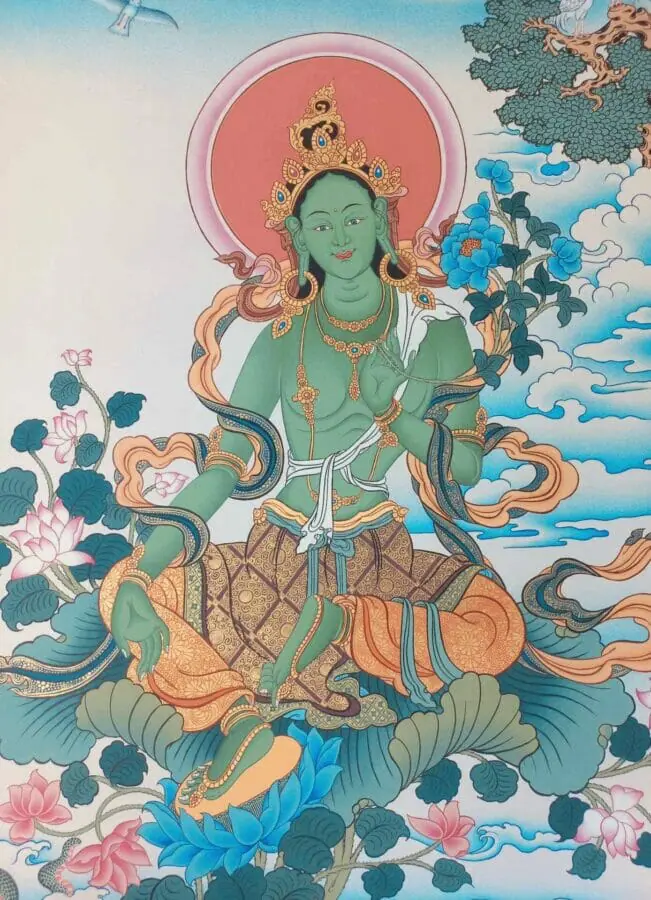There are a number of different stories about how Tara, the important female goddess of compassion in Buddhism, came into being. In one of these tales, she is thought to be the female counterpart of Avalokiteshvara, the bodhisattva of infinite compassion and mercy. In the story, Avalokiteshvara, who worked ceaselessly for all who suffer, looked at the world, and realized that the task at hand was so much greater than he had expected. Moreover, all his hard work did little to alleviate the suffering of the world. Realizing this, Avalokiteshvara fell into despair and began to weep. In one version, a lotus appeared from Avalokiteshvara’s tears, and Tara manifested as the flower bloomed and opened. Tara comforted Avalokiteshvara and told him that she would work with him to free all beings from suffering.

Wisdom Moon
Another version of her story was told by Taranatha, a Tibetan Lama who lived between the 16th and 17th centuries. In this version, Tara is said to have been a princes, a mortal woman, before becoming a bodhisattva. This princess was named Yeshe Dawa, which means ‘Moon of Primordial Awareness’ or ‘Wisdom Moon’. She lived millions of years ago. The princess was a great devotee of the Buddha of her time, Tonyo Drupa, and made many offerings to him over thousands of lifetimes. As she advanced on the path of enlightenment, she eventually came before the Buddha, and took the ‘Bodhisattva Vow’.
The monks who were present recognized her potential and urged her to pray for a male rebirth so that she may continue her progress on the path of enlightenment. The princess, however, saw the error in the monks’ point of view and told them that ‘male’ and ‘female’ are merely classifications created by the unenlightened minds of this world. The princess then made a vow – as long as suffering continued in the world, she would take on a female body to lead ALL beings, male or female, high born or low, and rich or poor, to enlightenment.

She who saves
In yet another story popular in the 7th century AD, Tara was believed to be the incarnation of every pious woman. In particular, the bodhisattva became associated with the two wives of the first Buddhist king of Tibet, Songsten Gampo, who is credited with the foundation of the Tibetan Empire. Songsten Gampo’s power extended well beyond the Tibetan Plateau and he ruled over Nepal as well as parts of India and China. Songsten Gampo is credited with the introduction of Buddhism in Tibet through his two wives. One of the king’s wives was a princess from China by the name of Wencheng, while the other was a Nepalese princess by the name of Bhrikuti. Both of the king’s wives are believed to be incarnations of Tara, the former being White Tara whereas the latter Green Tara.
But beyond and regardless of her particular story, in the Tibetan language, she is known also as ‘Sgrol-ma’, which may be translated to mean ‘she who saves’. This name reflects the role that Tara plays in Buddhism as a savior. Tara saves the faithful by showing them the way to enlightenment. Further, Tara protects her devotees from various calamities and helps them overcome the many obstacles that they may encounter in their lives.

About
Lopsang Lama is a traditional Tibetan artist. You can follow his artwork on Facebook and order his beautiful work directly from him. Find a masterpiece of sacred art to inspire for a lifetime: lopsanglama331@gmail.com

White Tara Mantra
OM TARE TUTTARE TURE MAMA AYUH PUNYA JNANA PUSTIME KURU SVAHA.
mama = mine, means that I would like to possess the following qualities.
ayur = long life
punya = merit that comes form living life ethically. [Tibetan: pune]
jnana = wisdom [Tibetan: gyana]
pushtim = increase [Tibetan: puntin]
kuru = do so! do it now!
svaha = hail, or may blessings be upon [Tibetan: soha]
With kind permission from Starfire Meditation